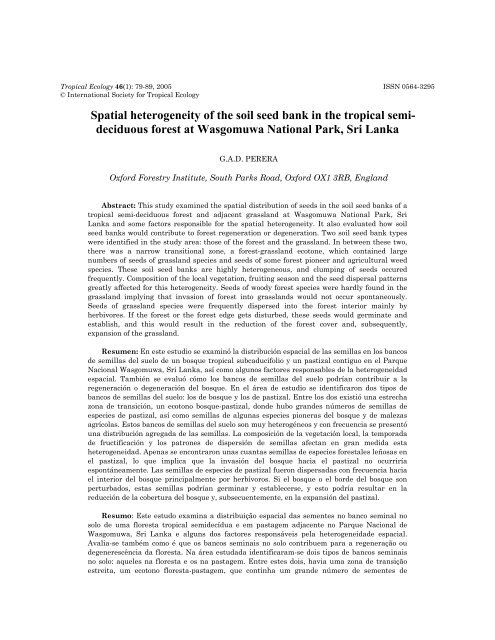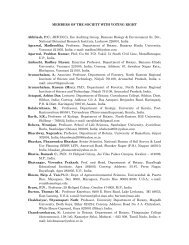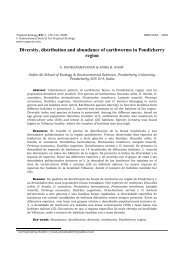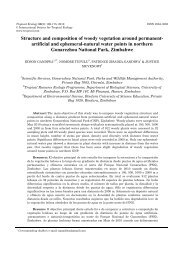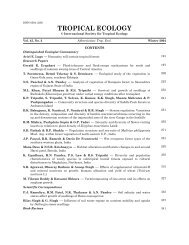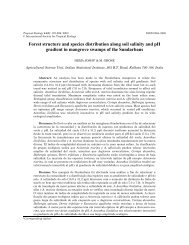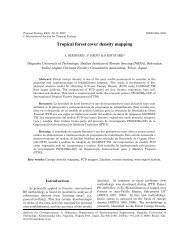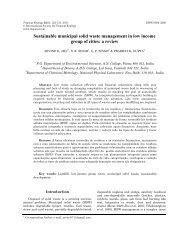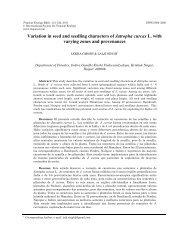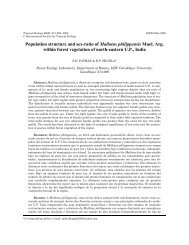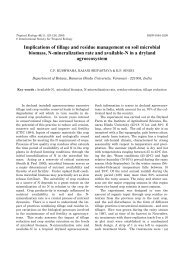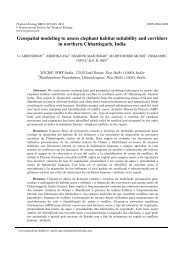Spatial heterogeneity of the soil seed bank in the tropical semi ...
Spatial heterogeneity of the soil seed bank in the tropical semi ...
Spatial heterogeneity of the soil seed bank in the tropical semi ...
You also want an ePaper? Increase the reach of your titles
YUMPU automatically turns print PDFs into web optimized ePapers that Google loves.
PERERA 79Tropical Ecology 46(1): 79-89, 2005 ISSN 0564-3295© International Society for Tropical Ecology<strong>Spatial</strong> <strong>heterogeneity</strong> <strong>of</strong> <strong>the</strong> <strong>soil</strong> <strong>seed</strong> <strong>bank</strong> <strong>in</strong> <strong>the</strong> <strong>tropical</strong> <strong>semi</strong>deciduousforest at Wasgomuwa National Park, Sri LankaG.A.D. PERERAOxford Forestry Institute, South Parks Road, Oxford OX1 3RB, EnglandAbstract: This study exam<strong>in</strong>ed <strong>the</strong> spatial distribution <strong>of</strong> <strong>seed</strong>s <strong>in</strong> <strong>the</strong> <strong>soil</strong> <strong>seed</strong> <strong>bank</strong>s <strong>of</strong> a<strong>tropical</strong> <strong>semi</strong>-deciduous forest and adjacent grassland at Wasgomuwa National Park, SriLanka and some factors responsible for <strong>the</strong> spatial <strong>heterogeneity</strong>. It also evaluated how <strong>soil</strong><strong>seed</strong> <strong>bank</strong>s would contribute to forest regeneration or degeneration. Two <strong>soil</strong> <strong>seed</strong> <strong>bank</strong> typeswere identified <strong>in</strong> <strong>the</strong> study area: those <strong>of</strong> <strong>the</strong> forest and <strong>the</strong> grassland. In between <strong>the</strong>se two,<strong>the</strong>re was a narrow transitional zone, a forest-grassland ecotone, which conta<strong>in</strong>ed largenumbers <strong>of</strong> <strong>seed</strong>s <strong>of</strong> grassland species and <strong>seed</strong>s <strong>of</strong> some forest pioneer and agricultural weedspecies. These <strong>soil</strong> <strong>seed</strong> <strong>bank</strong>s are highly heterogeneous, and clump<strong>in</strong>g <strong>of</strong> <strong>seed</strong>s occuredfrequently. Composition <strong>of</strong> <strong>the</strong> local vegetation, fruit<strong>in</strong>g season and <strong>the</strong> <strong>seed</strong> dispersal patternsgreatly affected for this <strong>heterogeneity</strong>. Seeds <strong>of</strong> woody forest species were hardly found <strong>in</strong> <strong>the</strong>grassland imply<strong>in</strong>g that <strong>in</strong>vasion <strong>of</strong> forest <strong>in</strong>to grasslands would not occur spontaneously.Seeds <strong>of</strong> grassland species were frequently dispersed <strong>in</strong>to <strong>the</strong> forest <strong>in</strong>terior ma<strong>in</strong>ly byherbivores. If <strong>the</strong> forest or <strong>the</strong> forest edge gets disturbed, <strong>the</strong>se <strong>seed</strong>s would germ<strong>in</strong>ate andestablish, and this would result <strong>in</strong> <strong>the</strong> reduction <strong>of</strong> <strong>the</strong> forest cover and, subsequently,expansion <strong>of</strong> <strong>the</strong> grassland.Resumen: En este estudio se exam<strong>in</strong>ó la distribución espacial de las <strong>semi</strong>llas en los bancosde <strong>semi</strong>llas del suelo de un bosque <strong>tropical</strong> subcaducifolio y un pastizal contiguo en el ParqueNacional Wasgomuwa, Sri Lanka, así como algunos factores responsables de la heterogeneidadespacial. También se evaluó cómo los bancos de <strong>semi</strong>llas del suelo podrían contribuir a laregeneración o degeneración del bosque. En el área de estudio se identificaron dos tipos debancos de <strong>semi</strong>llas del suelo: los de bosque y los de pastizal. Entre los dos existió una estrechazona de transición, un ecotono bosque-pastizal, donde hubo grandes números de <strong>semi</strong>llas deespecies de pastizal, así como <strong>semi</strong>llas de algunas especies pioneras del bosque y de malezasagrícolas. Estos bancos de <strong>semi</strong>llas del suelo son muy heterogéneos y con frecuencia se presentóuna distribución agregada de las <strong>semi</strong>llas. La composición de la vegetación local, la temporadade fructificación y los patrones de dispersión de <strong>semi</strong>llas afectan en gran medida estaheterogeneidad. Apenas se encontraron unas cuantas <strong>semi</strong>llas de especies forestales leñosas enel pastizal, lo que implica que la <strong>in</strong>vasión del bosque hacia el pastizal no ocurriríaespontáneamente. Las <strong>semi</strong>llas de especies de pastizal fueron dispersadas con frecuencia haciael <strong>in</strong>terior del bosque pr<strong>in</strong>cipalmente por herbívoros. Si el bosque o el borde del bosque sonperturbados, estas <strong>semi</strong>llas podrían germ<strong>in</strong>ar y establecerse, y esto podría resultar en lareducción de la cobertura del bosque y, subsecuentemente, en la expansión del pastizal.Resumo: Este estudo exam<strong>in</strong>a a distribuição espacial das sementes no banco sem<strong>in</strong>al nosolo de uma floresta <strong>tropical</strong> <strong>semi</strong>decídua e em pastagem adjacente no Parque Nacional deWasgomuwa, Sri Lanka e alguns dos factores responsáveis pela heterogeneidade espacial.Avalia-se também como é que os bancos sem<strong>in</strong>ais no solo contribuem para a regeneração oudegenerescência da floresta. Na área estudada identificaram-se dois tipos de bancos sem<strong>in</strong>aisno solo: aqueles na floresta e os na pastagem. Entre estes dois, havia uma zona de transiçãoestreita, um ecotono floresta-pastagem, que cont<strong>in</strong>ha um grande número de sementes de
80 SOIL SEED BANK AT WAGOMUWA NATIONAL PARKespécies de capim, sementes de algumas espécies florestais pioneiras e espécies <strong>in</strong>festantesagrícolas. Estes bancos sem<strong>in</strong>ais no solo são muito heterogéneos mostrando frequentesagrupamentos de sementes. Esta heterogeneidade afecta fortemente a composição da vegetaçãolocal, a estação de frutificação e os padrões de dispersão de sementes. As sementes de espéciesflorestais lenhosas dificilmente se encontravam na pastagem implicando que a <strong>in</strong>vasão dasflorestas nas pastagens não ocorre espontaneamente. Já as sementes das espécies da pastagemeram frequentemente dispersadas na <strong>in</strong>terior da floresta pr<strong>in</strong>cipalmente pelos herbívoros. Se afloresta, ou as suas margens, forem disturbadas, estas sementes germ<strong>in</strong>arão e estabelecer-seão,e de que resultará uma redução do coberto arbóreo e, subsequentemente, a expansão dapastagem.Key words: Proximity to <strong>seed</strong> source, <strong>seed</strong> dispersal, spatial heterogenity, <strong>tropical</strong> <strong>semi</strong>deciduousforest.Introduction<strong>Spatial</strong> <strong>heterogeneity</strong> <strong>of</strong> species and <strong>seed</strong>densities <strong>of</strong> <strong>soil</strong> <strong>seed</strong> <strong>bank</strong>s is well known for someecosystems like <strong>tropical</strong> humid forests (Whitmore1983) and temperate grasslands (Rice 1989; Rusch1992; Young et al. 1981). Grasslands <strong>of</strong>ten conta<strong>in</strong>large number <strong>of</strong> <strong>seed</strong>s and <strong>the</strong>ir <strong>seed</strong> <strong>bank</strong>s arepersistent. For example, Young et al. (1981)reported 27,400 <strong>seed</strong>s m -2 from Stipa grassland <strong>in</strong>California. Tropical ra<strong>in</strong> forests conta<strong>in</strong> largenumber <strong>of</strong> <strong>seed</strong>s <strong>in</strong> <strong>the</strong> <strong>soil</strong> <strong>of</strong> many pioneer species(Whitmore 1983). In contrast, <strong>the</strong> density <strong>of</strong> <strong>seed</strong>s<strong>in</strong> <strong>tropical</strong> dry forests is found to be low. For<strong>in</strong>stance, Lieberman (1979) found a maximum <strong>of</strong>160 <strong>seed</strong>s m -2 <strong>in</strong> a dry forest <strong>in</strong> Ghana while Hall& Swa<strong>in</strong>e (1980) reported 100 - 700 <strong>seed</strong>s m -2 <strong>in</strong> adry forest <strong>in</strong> <strong>the</strong> same country. In a <strong>tropical</strong> <strong>semi</strong>deciduousforest at Sigiriya Sanctuary, Sri Lanka,<strong>soil</strong> <strong>seed</strong> density <strong>of</strong> 166 ± 127 <strong>seed</strong>s m -2 wasreported (Perera 2005 <strong>in</strong> press).Soil <strong>seed</strong> <strong>bank</strong>s <strong>in</strong> <strong>tropical</strong> humid forests arefound to be highly heterogenous (Garwood 1989;Uhl et al. 1981). Some factors which results <strong>in</strong> highspatial <strong>heterogeneity</strong> <strong>of</strong> <strong>soil</strong> <strong>seed</strong> <strong>bank</strong>s are <strong>the</strong><strong>seed</strong> dispersal patterns <strong>of</strong> <strong>the</strong> different species(Hall & Swa<strong>in</strong>e 1980; Nepstad et al. 1996; Swa<strong>in</strong>e& Hall 1983; Uhl et al. 1981), edaphic factors (e.g.dra<strong>in</strong>age) (Garwood 1989), fire and <strong>seed</strong> predation(Perera, unpublished data). Such constra<strong>in</strong>s affect<strong>seed</strong> germ<strong>in</strong>ation while <strong>the</strong> time <strong>of</strong> disturbancerelative to flower<strong>in</strong>g may limit <strong>the</strong> number <strong>of</strong> <strong>seed</strong>sand species that <strong>in</strong>vade a site (Epp 1987).Accord<strong>in</strong>g to Geritz et al. (1984) and Hartshorn(1980), proximity to a <strong>seed</strong> source is important <strong>in</strong>determ<strong>in</strong><strong>in</strong>g <strong>the</strong> successful colonization andregeneration <strong>of</strong> species <strong>in</strong> a disturbed site. Thisseems to be more relevant to <strong>the</strong> colonization <strong>of</strong>small canopy gaps <strong>in</strong> forests.Tropical <strong>semi</strong>-deciduous forests <strong>in</strong> Sri Lankaare highly disturbed and large canopy gaps occuras a result <strong>of</strong> shift<strong>in</strong>g cultivation (Perera 2001).Regeneration <strong>of</strong> tree species do not occurfrequently <strong>in</strong> <strong>the</strong>se large gaps (Holmes 1954;Perera 2001; Rosayro 1961) and, <strong>the</strong>refore, it isnecessary to assist natural regeneration (Perera etal. 1995; Perera 2001).Soil <strong>seed</strong> <strong>bank</strong>s play a major role <strong>in</strong> naturalregeneration after disturbances such as fire,logg<strong>in</strong>g and overgraz<strong>in</strong>g <strong>in</strong> humid environments(Grime 1981; Roberts 1981; Swa<strong>in</strong>e & Hall 1983),and determ<strong>in</strong><strong>in</strong>g <strong>the</strong> composition and density <strong>of</strong><strong>seed</strong> <strong>bank</strong>s is considered as an essential step <strong>in</strong>artificial restoration <strong>of</strong> degraded vegetation (vander Valk 1989). Therefore, it is necessary toexam<strong>in</strong>e whe<strong>the</strong>r <strong>the</strong> disturbed <strong>tropical</strong> <strong>semi</strong>deciduousforests <strong>of</strong> Sri Lanka could berehabilitated by us<strong>in</strong>g <strong>the</strong>ir <strong>soil</strong> <strong>seed</strong> <strong>bank</strong>s.The objectives <strong>of</strong> this study were to exam<strong>in</strong>e<strong>the</strong> spatial distribution <strong>of</strong> <strong>seed</strong>s <strong>in</strong> <strong>the</strong> <strong>soil</strong> <strong>seed</strong><strong>bank</strong> <strong>of</strong> a <strong>tropical</strong> <strong>semi</strong>-deciduous forest <strong>of</strong> SriLanka and factors responsible for <strong>the</strong> spatial<strong>heterogeneity</strong>. It also assesses <strong>the</strong> potential role <strong>of</strong><strong>the</strong> <strong>soil</strong> <strong>seed</strong> <strong>bank</strong> <strong>in</strong> forest regeneration andevaluates how far <strong>the</strong> proximity to forests affects<strong>in</strong> <strong>the</strong> regeneration <strong>of</strong> forests <strong>in</strong> grasslands, whichare situated adjacent to forests.
PERERA 81Materials and methodsStudy siteThe research was conducted at <strong>the</strong>Wasgomuwa National Park <strong>in</strong> <strong>the</strong> dry zone <strong>of</strong> SriLanka (7 o 34' - 7 o 57' North and 80 o 51' - 81 o 05'East) (Fig. 1), which extended over 37,063 ha area(Green 1990). The forest and adjacent grassland <strong>in</strong><strong>the</strong> sou<strong>the</strong>rn half <strong>of</strong> <strong>the</strong> park were selected for <strong>the</strong>study. The <strong>soil</strong>s <strong>in</strong> <strong>the</strong> area are reddish brown withsome alluvial deposits, and <strong>the</strong> pH varies between6 - 8 (Jayas<strong>in</strong>gham 1991). Generally, <strong>the</strong> meanannual ra<strong>in</strong>fall <strong>in</strong> <strong>the</strong> dry zone <strong>of</strong> Sri Lanka isabout 1000-1900 mm year -1 (Rosayro 1950). Thera<strong>in</strong> is ma<strong>in</strong>ly brought by <strong>the</strong> north-east monsoonbetween October and February. The south-westmonsoon br<strong>in</strong>gs less ra<strong>in</strong> between March and May.Dry periods occur <strong>in</strong> between monsoonal periodsthough <strong>in</strong>termonsoonal ra<strong>in</strong>s also occur. Manmade fires periodically burn <strong>the</strong> grass vegetation.The vegetation <strong>of</strong> <strong>the</strong> area is ma<strong>in</strong>lycharacteristic <strong>of</strong> a <strong>tropical</strong> <strong>semi</strong>-deciduous forests<strong>of</strong> Sri Lanka (Jayas<strong>in</strong>gham 1991). Characteristicspecies <strong>in</strong>clude Berrya cordifolia (Willd.) Burret,Chloroxylon swietenia DC, Drypetes sepiaria(Wight and Am.) Pax. and H<strong>of</strong>fm. and Diospyrosspp. Over <strong>the</strong> forested area, 155 species belong<strong>in</strong>gto 47 families have been identified <strong>in</strong>clud<strong>in</strong>g 107trees, 34 shrubs, 13 lianas and 2 climbers(Jayas<strong>in</strong>gham 1991). The Euphorbiaceae,Legum<strong>in</strong>osae and Rutaceae are <strong>the</strong> dom<strong>in</strong>antfamilies (Jayas<strong>in</strong>gham 1991). Some parts wereheavily disturbed by a cyclone <strong>in</strong> 1978 and <strong>the</strong>seareas have more light demand<strong>in</strong>g forest pioneerspecies.Jayas<strong>in</strong>gham (1991) identified twograssland types <strong>in</strong> <strong>the</strong> area and named <strong>the</strong>m asImperata grasslands and Ischemum/Eragrostisgrasslands. The former occurs widely over <strong>the</strong>area and is dom<strong>in</strong>ated by Imperata cyl<strong>in</strong>dricawhile <strong>the</strong> latter occurs towards <strong>the</strong> easternboundary and is dom<strong>in</strong>ated by Eragrostis sp.and Ischemum sp.Soil sampl<strong>in</strong>gSampl<strong>in</strong>g was done at <strong>the</strong> early period <strong>of</strong> <strong>the</strong>ma<strong>in</strong> ra<strong>in</strong>y season (November 1995). Fourtransects were established at right angles to <strong>the</strong>forest-grassland boundary <strong>in</strong> randomly selectedlocations across slight altitud<strong>in</strong>al gradientdistances <strong>of</strong> 0, 5, 25, 125, 625 and 3125 metrewere marked along <strong>the</strong>se transects from <strong>the</strong>forest-grassland boundary <strong>in</strong>to <strong>the</strong> forest and<strong>the</strong> grassland. In most <strong>of</strong> <strong>the</strong> places, <strong>the</strong> length<strong>of</strong> <strong>the</strong> grassland was less than 3 km from <strong>the</strong>boundary. In such transects, <strong>the</strong> <strong>soil</strong> sampleswere collected from <strong>the</strong> fur<strong>the</strong>st available po<strong>in</strong>t(fp) <strong>in</strong> <strong>the</strong> grassland, which varied between 2000to 3125 m.At each distance along <strong>the</strong> transect, 20 ml<strong>in</strong>es perpendicular to <strong>the</strong> transect were marked.Ten <strong>soil</strong> samples (surface area = 15 x 15 cm;depth = 4 cm) were collected at 2 m <strong>in</strong>tervalsalong <strong>the</strong>se l<strong>in</strong>es. Soil samples were brought to<strong>the</strong> shade house thatched with transparentplastic corrugated sheets, and <strong>the</strong> 10 <strong>soil</strong>samples collected at each distance were mixedtoge<strong>the</strong>r and spread over sterilized sand beds(surface area <strong>of</strong> <strong>the</strong> sand bed was one squaremeter and depth <strong>of</strong> <strong>the</strong> sand layer was fivecentimeters). The beds were well watered us<strong>in</strong>ga hand held f<strong>in</strong>e sprayer and germ<strong>in</strong>ants wereobserved and recorded for 110 days. Seventydays after <strong>the</strong> orig<strong>in</strong>al spread<strong>in</strong>g <strong>the</strong> <strong>soil</strong> surfacewas lightly scarified <strong>in</strong> order to expose buried<strong>seed</strong>s if any. Six sand beds were left withoutany <strong>soil</strong> to detect any contam<strong>in</strong>ation <strong>in</strong> <strong>the</strong>shade house. Dicot <strong>seed</strong>l<strong>in</strong>gs which could not beidentified when very young were potted andidentified after 7-8 months.Fig. 1. Location <strong>of</strong> <strong>the</strong> study site and transects.
82 SOIL SEED BANK AT WAGOMUWA NATIONAL PARKResultsSpecies composition and distribution <strong>in</strong> <strong>the</strong><strong>soil</strong> <strong>seed</strong> <strong>bank</strong>sThree major groups <strong>of</strong> sample plots wereidentified <strong>in</strong> <strong>the</strong> TWINSPAN (Hill 1979) sampleplot dendrogram (Fig. 2a) represent<strong>in</strong>g <strong>the</strong> <strong>soil</strong><strong>seed</strong> <strong>bank</strong>s <strong>of</strong> forest <strong>in</strong>terior, grassland <strong>in</strong>teriorand a transitional area (ecotone) between <strong>the</strong>setwo. The group <strong>of</strong> <strong>soil</strong> samples denoted as forest<strong>in</strong>terior were collected <strong>in</strong> <strong>the</strong> forest beyond 5 mfrom <strong>the</strong> forest grassland boundary (Fig. 2a). Thegrassland <strong>in</strong>terior <strong>soil</strong> samples <strong>in</strong>clude thosecollected <strong>in</strong> <strong>the</strong> grassland beyond 25 m from <strong>the</strong>boundary. Soil samples taken up to 5 m <strong>in</strong> <strong>the</strong>forest and 25 m <strong>in</strong> <strong>the</strong> grassland were similar <strong>in</strong>species composition and abundance and appear asforest-grassland ecotone. The species dendrogram(Fig. 2b) clearly showed that <strong>the</strong> <strong>soil</strong> <strong>of</strong> forestgrasslandecotone conta<strong>in</strong>ed <strong>seed</strong>s <strong>of</strong> someagricultural weeds or plants that grow <strong>in</strong> forestfr<strong>in</strong>ges and disturbed environments, e.g. Ageratumconyzoides L., Chromalaena odorata (L.) R.M. K<strong>in</strong>gand H. Rob<strong>in</strong>son and Lantana camara L. <strong>in</strong>addition to o<strong>the</strong>r forest and grassland species(Table 1).However, a few number <strong>of</strong> sample plots haveshown some exceptional characteristics. In <strong>the</strong>TWINSPAN sample plot dendrogram (Fig. 2a), <strong>the</strong>grassland <strong>in</strong>terior samples, G3:125; G1:125; G3:fpand G4:625 were grouped with <strong>the</strong> ecotonesamples. This is due to <strong>the</strong> similarities <strong>of</strong> speciesabundance and composition <strong>of</strong> <strong>the</strong>se samples to <strong>the</strong><strong>soil</strong> at forest-grassland ecotone, ma<strong>in</strong>ly, by hav<strong>in</strong>gmany <strong>seed</strong>s <strong>of</strong> Ageratum conyzoides and L<strong>in</strong>derniacrustacea. The boundary samples G4:5 and G4:25were grouped with grassland <strong>in</strong>terior samplesbecause <strong>of</strong> <strong>the</strong> absence <strong>of</strong> <strong>seed</strong>s <strong>of</strong> <strong>the</strong> typicalgrassland species L<strong>in</strong>dernia crustacea <strong>in</strong> <strong>the</strong>m.The boundary samples F1:5; F2:5 and F4:5 showedsimilarities to forest <strong>in</strong>terior because <strong>of</strong> <strong>the</strong>presence <strong>of</strong> <strong>seed</strong>s <strong>of</strong> Secur<strong>in</strong>ega leucopyrus (Willd.)Mueller and Cl<strong>in</strong>opodium umbrosum (Bieb.) Koch<strong>in</strong> large amounts. In addition, <strong>the</strong> forest <strong>in</strong>teriorsample F1:125 lied with boundary samples ma<strong>in</strong>ly(a ). Dendrogram <strong>of</strong> sample plotsF4:3125F2:25F2:125F2:625F1:625F3:3125F4:625F3:125F3:625F1:125F1:3125F2:3125F3:25F4:5F4:25F1:5F1:25F2:5F3:0F4:0F4:125G1:0G1:5G1:25G3:5G3:25G3:125F1:0G1:125G2:0G2:5G2:25G3:fpG4:625F2:0G3:0G4:0F3:5G1:625G1:fpG3:625G4:5G4:25G4:125G2:125G2:625G2:fpG4:fpforest <strong>in</strong>terior forest-grassland boundary grassland <strong>in</strong>terior( b ). Dendrogram <strong>of</strong> speciesBerrya cordifolia Aristolochia <strong>in</strong>dica Solanum melong<strong>in</strong>a var. Premna tomentosa Phyllanthus amarus Melochia corchorifolia Sida cordata Sida cordifoliaDiplodiscus verrucosus Carmona retusa Flueggea leucopyrus Aerva lanata Portulaca oleracea Eclipta prostrata Oldenlandia sp. Euphorbia hirtaMemecylon umbellatum Lepisan<strong>the</strong>s tetraphylla Salacia oblonga Mimosa pudica Rothia <strong>in</strong>dica Oldenlandia herbacea Tephrosia purppureaCassia fistula Vitex altissima Peperomia pellucida Ageratum conyzoides Phyllanthus sp. Ocimum canum L<strong>in</strong>dernia crustaceaCucumis pubescens Walsura trifoliolata Cl<strong>in</strong>opodium umbrosum Scoparia dulcis Hygrophila sp<strong>in</strong>osa Leucas zeylanica Cassia toraGlycosmis mauritiana Euphorbia heterophylla Ziziphus oenoplia Ipomoea triloba Aeschynomene americanaStresblus asper Phyllanthus reticulatus Polyalthia kor<strong>in</strong>ti Desmodium triflorumToddalia asiatica Lantana camara Calotropis gigantesSelag<strong>in</strong>ella spp . Helicteres isora Achyran<strong>the</strong>s asperaChromolaena odorataCleisanthus pallidusforest <strong>in</strong>terior forest - grassland boundary or <strong>the</strong> grassland <strong>in</strong>teriordisturbed forest <strong>in</strong>teriorFig. 2. Dendrogram <strong>of</strong> (a) sample plots and (b) species produced by TWINSPAN <strong>of</strong> species abundance data <strong>of</strong> <strong>the</strong> <strong>soil</strong><strong>seed</strong> <strong>bank</strong> at Wasgomuwa National Park, Sri Lanka. Alphabets <strong>in</strong> <strong>the</strong> abbreviated names show forest (F) or grassland(G) with subsequent first numeral <strong>in</strong>dicat<strong>in</strong>g replicate number (F1..F4) and second numeral after colon showsdistance along transects from forest-grassland boundary. fp is <strong>the</strong> distance to <strong>the</strong> fur<strong>the</strong>st po<strong>in</strong>t that sampled with<strong>in</strong><strong>the</strong> grassland.
PERERA 83due to abundance <strong>of</strong> Ageratum conyzoides <strong>seed</strong>s, acharacteristic feature <strong>of</strong> <strong>the</strong> <strong>soil</strong> <strong>seed</strong> <strong>bank</strong> <strong>of</strong> <strong>the</strong>ecotone.Seeds <strong>of</strong> forest species were, ma<strong>in</strong>ly, present<strong>in</strong> <strong>the</strong> forest <strong>soil</strong> <strong>seed</strong> <strong>bank</strong> although a few <strong>of</strong><strong>the</strong>m were also found <strong>in</strong> <strong>the</strong> <strong>soil</strong> <strong>seed</strong> <strong>bank</strong> <strong>of</strong> <strong>the</strong>forest-grassland ecotone (Table 1). They were,however, hardly found <strong>in</strong> <strong>the</strong> grassland <strong>soil</strong> <strong>seed</strong><strong>bank</strong>. Most <strong>of</strong> <strong>the</strong> typical grassland species werefound <strong>in</strong> <strong>the</strong> forest <strong>soil</strong> although <strong>the</strong>y were found<strong>in</strong> <strong>the</strong> <strong>soil</strong> <strong>seed</strong> <strong>bank</strong>s <strong>of</strong> <strong>the</strong> grassland and <strong>the</strong>ecotone <strong>in</strong> large quantities. When <strong>the</strong> woodyspecies were considered, it became evident that<strong>seed</strong>s <strong>of</strong> <strong>the</strong> most common woody forest specieswere not represented <strong>in</strong> <strong>the</strong> <strong>soil</strong> <strong>seed</strong> <strong>bank</strong>except for Diplodiscus verrucosus (Thw.)Kosterm. and Memecylon umbellatum Burm. f.(Table 2).Density <strong>of</strong> <strong>seed</strong>s <strong>in</strong> <strong>the</strong> surface <strong>soil</strong>Seed densities <strong>in</strong> <strong>the</strong> <strong>soil</strong> varied significantlywith <strong>the</strong> distance form <strong>the</strong> forest grasslandboundary (one way ANOVA: P < 0.001). The mean<strong>seed</strong> density was higher <strong>in</strong> <strong>the</strong> grassland (8339 ±918) and at <strong>the</strong> forest-grassland ecotone grassland(6990 ± 2751)(Fig. 3). However, <strong>the</strong>re was anabrupt decl<strong>in</strong>e <strong>in</strong> <strong>the</strong> densities <strong>of</strong> <strong>seed</strong>s <strong>in</strong> <strong>the</strong> <strong>soil</strong>beyond 5 m distance <strong>in</strong>to <strong>the</strong> forest and <strong>the</strong> density<strong>of</strong> <strong>the</strong> forest <strong>soil</strong> <strong>seed</strong> <strong>bank</strong> was 583 ± 236. Therewas a very high <strong>in</strong>teraction between <strong>the</strong> distanceand <strong>the</strong> transects (blocks), especially <strong>in</strong> <strong>the</strong>Table 1. Distribution <strong>of</strong> typical forest and grassland species (as a percentage <strong>of</strong> <strong>the</strong> total number <strong>of</strong> plots <strong>in</strong> eachcategory) <strong>in</strong> <strong>the</strong> two <strong>soil</strong> <strong>seed</strong> <strong>bank</strong> types and at <strong>the</strong> forest-grassland ecotone.Species category Species Grassland<strong>in</strong>teriorFrequency (%)Forest-grasslandecotoneForest <strong>in</strong>teriorForest species Diplodiscus verrucosus 0 5 19Peperomia pellucida 0 10 38Flueggea leucopyrus 0 35 75Walsura trifoliolata 0 0 25Grassland species Ageratum conyzoides 33 85 38Phyllanthus amarus 8 10 7L<strong>in</strong>dernia crustacea 58 75 19Desmodium triflorum 25 55 0Oldenlandia herbacea 42 60 0Ocimum canum 25 25 6Scoparia dulcis 50 25 7Mimosa pudica 67 55 31Table 2. Dom<strong>in</strong>ant woody species <strong>in</strong> <strong>the</strong> stand<strong>in</strong>g vegetation and <strong>the</strong> on <strong>the</strong> <strong>soil</strong> (Species <strong>in</strong> each category arearranged <strong>in</strong> descend<strong>in</strong>g order <strong>of</strong> abundance).Forest vegetation (studied by Jayas<strong>in</strong>gham 1991)Dimorphocalyx glabellus, Mallotus rhamnifolius,Glycosmis sp., Polyalthia kor<strong>in</strong>ti, Diospyrosovalifolia, Diplodiscus verrucosus, Memecylonumbellatum, Drypetes sepiaria, Catunaregamsp<strong>in</strong>osa, Phyllanthus polyphyllusSoil <strong>seed</strong> <strong>bank</strong> estimated by <strong>the</strong> current studyForest <strong>in</strong>teriorFlueggea leucopyrus, Chromolaena odorata, Diplodiscusverrucosus, Memecylon umbellatum, Salacia oblonga, Walsuratrifoliolata, Phyllanthus reticulatusForest - grassland ecotoneFlueggea leucopyrus, Chromolaena odorata, Phyllanthusreticulatus, Diplodiscus verrucosusGrassland <strong>in</strong>teriorAristolochia <strong>in</strong>dica, Calotropis gigantea
84 SOIL SEED BANK AT WAGOMUWA NATIONAL PARKgrassland despite that it was not statisticallysignificant (Fig. 4).A total <strong>of</strong> 42,054 <strong>seed</strong>s germ<strong>in</strong>ated from all <strong>soil</strong>samples, 64% <strong>of</strong> which were grasses. The meandensities <strong>of</strong> <strong>seed</strong>s <strong>of</strong> grass species weresignificantly higher <strong>in</strong> <strong>the</strong> grassland and at <strong>the</strong>ecotone (Fig. 3; one way ANOVA: P < 0.001). Thedensities <strong>of</strong> <strong>seed</strong>s <strong>of</strong> o<strong>the</strong>r species except grasses,(i.e., o<strong>the</strong>r herbs, shrubs and trees) also variedsignificantly with <strong>the</strong> distance along transects(Fig. 5; one way ANOVA: p = 0.003 for herbs; P
PERERA 85by Hurlburt’s rarefaction method with 95% confidencelimits (Also see <strong>the</strong> Figure 2a for <strong>the</strong> <strong>soil</strong> <strong>seed</strong> <strong>bank</strong>types).Ecology and <strong>seed</strong> dispersal patterns <strong>of</strong> forestspeciesAll woody species found at <strong>the</strong> forestgrasslandecotone area were forest pioneerspecies (sensu Whitmore 1990), but <strong>seed</strong>s <strong>of</strong> bothpioneer and climax species were found <strong>in</strong> <strong>the</strong>forest <strong>in</strong>terior (Table 3). Seeds <strong>of</strong> w<strong>in</strong>d dispersedpioneerstem tw<strong>in</strong>er Aristolochia <strong>in</strong>dica L. werefound <strong>in</strong> both forest and grassland. Seeds <strong>of</strong> mostwoody forest species were dispersed by animalsand <strong>the</strong>y were not found <strong>in</strong> <strong>the</strong> grassland <strong>in</strong>terior(Table 3). In contrast, <strong>the</strong> grassland species weredispersed by both w<strong>in</strong>d and animals, and <strong>the</strong>sewere also found <strong>in</strong> <strong>the</strong> forest and at <strong>the</strong> forestedge. Seeds <strong>of</strong> <strong>in</strong>vasive agricultural weed species:Chromalaena odorata and Lantana camara L.were present at <strong>the</strong> ecotone area <strong>in</strong> largequantities.Table 3. Abundance <strong>of</strong> <strong>seed</strong>s <strong>of</strong> woody species <strong>in</strong> <strong>the</strong> <strong>soil</strong> <strong>seed</strong> <strong>bank</strong> along transects, <strong>the</strong> ecology <strong>of</strong> <strong>seed</strong>s and <strong>the</strong>irmajor dispersal agent (The first digit <strong>in</strong>dicates <strong>the</strong> frequency <strong>of</strong> <strong>seed</strong>s out <strong>of</strong> 4 replicated (transects) while <strong>the</strong> latterdigit <strong>in</strong>dicates <strong>the</strong> total number <strong>of</strong> <strong>seed</strong>s found). fp is <strong>the</strong> distance to <strong>the</strong> fur<strong>the</strong>st po<strong>in</strong>t that sampled with<strong>in</strong> <strong>the</strong>grassland.Sampl<strong>in</strong>g distance from forest-grassland boundary (m)Species Ecology Dispersal Forest GrasslandTreesAgent 3125 625 125 25 5 0 0 5 25 125 625 fpLepisan<strong>the</strong>s tetraphylla Climax Mammal 2/3Streblus asper Pioneer Bird 1/1Berrya cordifolia Climax W<strong>in</strong>d 2/4 1/1Cassia fistula Climax Mammal 1/1Vitex altissima Climax Bird 1/1 2/3 1/1 1/2Walsura trifoliolata Climax Bird 2/3 1/5 1/3Diplodiscus verrucosus Pioneer Bird 1/3 1/2 1/10 1/15Premna tomentosa Pioneer Bird 1/2 1/2ShrubsMemecylon umbellatum Climax Bird 1/4 2/7Salacia oblonga Pioneer Bird/ 3/9 1/1 1/1MammalHelicteres isora Pioneer 1/2 1/1 1/2Glycosmis mauritiana Climax Bird 1/1Toddalia asiatica Pioneer Bird 1/1Carmona retusa Climax Bird 1/2 2/3Flueggea leucopyrus Pioneer Bird/ 3/11 3/6 3/11 3/15 3/48 3/26 1/7MammalChromolaena odorata* Weed W<strong>in</strong>d 1/7 2/17 2/23 3/55Polyalthia kor<strong>in</strong>ti Climax Mammal 1/1Ziziphus oenoplia Pioneer Bird/1/1 1/1MammalLantana camara Weed Bird 1/1Phyllanthus reticulatus Pioneer Mammal 2/2 1/2 2/2 1/4 1/14 3/10 1/1 1/1Calotropis gigantea* Pioneer W<strong>in</strong>d 1/1ClimbersAristolochia <strong>in</strong>dica * Pioneer W<strong>in</strong>d 2/2 1/1 1/2 1/1* <strong>semi</strong>-woody speices
86 SOIL SEED BANK AT WAGOMUWA NATIONAL PARKDiscussionTwo dist<strong>in</strong>ct <strong>soil</strong> <strong>seed</strong> <strong>bank</strong> types could beidentified <strong>in</strong> <strong>the</strong> study area, namely <strong>the</strong> forest and<strong>the</strong> grassland <strong>soil</strong> <strong>seed</strong> <strong>bank</strong>s. Between <strong>the</strong>se two<strong>seed</strong> <strong>bank</strong>s, <strong>the</strong>re was a transitional zone, which<strong>in</strong>cluded samples collected at <strong>the</strong> forest-grasslandecotone, i.e. <strong>the</strong> samples collected between 5 m <strong>in</strong>to<strong>the</strong> forest and 25 m <strong>in</strong>to <strong>the</strong> grassland form <strong>the</strong>forest-grassland marg<strong>in</strong>. The ecotone <strong>soil</strong> <strong>seed</strong><strong>bank</strong> was formed due to <strong>the</strong> accumulation <strong>of</strong> <strong>seed</strong>s<strong>of</strong> grassland species (grasses and herbs) with someforest pioneer and agricultural weed species.As <strong>in</strong> temperate grasslands (Rice 1989; Rusch1992) <strong>the</strong> <strong>seed</strong> density <strong>in</strong> <strong>the</strong> <strong>soil</strong> <strong>of</strong> <strong>the</strong> <strong>tropical</strong>grassland at Wasgomuwa was very high (8399 ±918). This can be expla<strong>in</strong>ed by <strong>the</strong> high <strong>seed</strong>production <strong>of</strong> grasses and herbs, <strong>the</strong>ir longviability and capability to withstand harshenvironments. More than 50% <strong>of</strong> <strong>the</strong> <strong>seed</strong>s <strong>in</strong> <strong>the</strong><strong>soil</strong> <strong>of</strong> <strong>the</strong> grassland were grasses. The only shrubfound <strong>in</strong> <strong>the</strong> grassland <strong>in</strong>terior was Calotropisgigantea, which is not a forest species.As <strong>in</strong> o<strong>the</strong>r <strong>tropical</strong> <strong>semi</strong>-deciduous forests <strong>in</strong>Sri Lanka (Perera 2005 <strong>in</strong> press) and <strong>in</strong> Ghana(Hall & Swa<strong>in</strong>e 1980; Lieberman 1979), <strong>the</strong>average density <strong>of</strong> <strong>seed</strong>s <strong>in</strong> <strong>the</strong> <strong>soil</strong> <strong>seed</strong> <strong>bank</strong> <strong>of</strong><strong>the</strong> forest at Wasgomuwa was low (583 ± 236) andconta<strong>in</strong>ed <strong>seed</strong>s <strong>of</strong> grass and dicotyledonous herbs<strong>in</strong> large quantities (Figs. 3 & 5). Some parts <strong>of</strong> <strong>the</strong>forest <strong>in</strong>terior had been disturbed by <strong>the</strong> cyclone <strong>in</strong>1978 and <strong>the</strong> <strong>seed</strong> <strong>bank</strong> <strong>of</strong> such disturbed patchesconta<strong>in</strong>ed some species, which characterize <strong>the</strong>forest - grassland boundary, i.e. <strong>seed</strong>s <strong>of</strong> someagricultural weeds such as Chromalaena odorataand Lantana camara.Seeds <strong>of</strong> tree and shrub species were found <strong>in</strong>samples collected <strong>in</strong>side <strong>the</strong> forest and at <strong>the</strong>ecotone while those <strong>of</strong> climax species were onlyfound from <strong>the</strong> forest <strong>in</strong>terior (Table 3). Thespecies richness is also high <strong>in</strong> <strong>the</strong> forest <strong>soil</strong> <strong>seed</strong><strong>bank</strong> (Fig. 6). As <strong>in</strong> humid ra<strong>in</strong> forests, (Whitmore1983), most <strong>of</strong> <strong>the</strong> woody forest species <strong>of</strong> <strong>the</strong>stand<strong>in</strong>g vegetation were not represented <strong>in</strong> <strong>the</strong><strong>soil</strong> <strong>seed</strong> <strong>bank</strong> (Table 2). However, Diplodiscusverrucosus and Memecylon umbellatum wererepresented both <strong>in</strong> <strong>the</strong> stand<strong>in</strong>g forest vegetationand <strong>the</strong> <strong>soil</strong> <strong>seed</strong> <strong>bank</strong>. This may be due to <strong>the</strong>ability <strong>of</strong> <strong>the</strong> species to produce a plethora <strong>of</strong> <strong>seed</strong>sand/or because sampl<strong>in</strong>g was done <strong>in</strong> <strong>the</strong> fruit<strong>in</strong>gseason. The fruit<strong>in</strong>g season <strong>of</strong> <strong>the</strong>se species isbetween September to January and, <strong>the</strong>refore,viable <strong>seed</strong>s <strong>of</strong> <strong>the</strong>se species may be available <strong>in</strong><strong>the</strong> <strong>soil</strong> when sampl<strong>in</strong>g was done <strong>in</strong> lateNovember. Some o<strong>the</strong>r species like Chromolaenaodorata and Flueggea leucopyrus have long lived<strong>seed</strong>s and <strong>the</strong>y may form a persistent <strong>seed</strong> <strong>bank</strong>.In agreement with reports <strong>of</strong> Garwood (1989)and Uhl et al. (1981), <strong>soil</strong> <strong>seed</strong> <strong>bank</strong>s <strong>of</strong>Wasgomuwa National Park are highlyheterogeneous, and local variations were alsoobserved <strong>in</strong> a given <strong>soil</strong> <strong>seed</strong> <strong>bank</strong> type (Figs. 2a &4). In <strong>the</strong> sample plot dendrogram (Fig. 2a), somegrassland <strong>in</strong>terior samples have been grouped with<strong>the</strong> forest-grassland ecotone sample group because<strong>the</strong>se samples conta<strong>in</strong>ed <strong>seed</strong>s <strong>of</strong> L<strong>in</strong>derniacrustacea and Ageratum conyzoides abundantly,which is a characteristic <strong>of</strong> <strong>the</strong> ecotone area.Similarly, two <strong>of</strong> <strong>the</strong> ecotone <strong>soil</strong> samples havebeen grouped with grassland <strong>in</strong>terior samples dueto <strong>the</strong> absence <strong>of</strong> <strong>seed</strong>s <strong>of</strong> L<strong>in</strong>dernia crustacea <strong>in</strong><strong>the</strong>m. Accord<strong>in</strong>g to Garwood (1989), suchsituations may arise due to localized <strong>seed</strong> dispersalpatterns such as presence <strong>of</strong> dra<strong>in</strong>age flows.As <strong>in</strong> typical forest <strong>in</strong>terior samples, <strong>the</strong>presence <strong>of</strong> Flueggea leucopyrus and Cl<strong>in</strong>opodiumumbrosum <strong>seed</strong>s <strong>in</strong> a large quantity has causedsome forest edge samples to be grouped with forest<strong>in</strong>terior samples. Such situations are caused by <strong>the</strong>local composition <strong>of</strong> <strong>the</strong> stand<strong>in</strong>g vegetation <strong>in</strong>addition to localised <strong>seed</strong> dispersal patterns.Aubréville (1938) has described <strong>the</strong> spatial<strong>heterogeneity</strong> and mosaic nature <strong>of</strong> stand<strong>in</strong>gvegetation, and similarly spatial <strong>heterogeneity</strong> <strong>of</strong><strong>the</strong> <strong>seed</strong> <strong>bank</strong> may occur.In <strong>the</strong> sample plot dendrogram, <strong>the</strong> forest<strong>in</strong>terior sample F4:125 was grouped with ecotone<strong>soil</strong> samples and <strong>the</strong> presence <strong>of</strong> Ageratumconyzoides <strong>seed</strong>s <strong>in</strong> a large quantity, which is acharacteristic feature <strong>of</strong> <strong>the</strong> <strong>soil</strong> <strong>of</strong> <strong>the</strong> forestgrasslandecotone area. This implies that <strong>the</strong>particular sampl<strong>in</strong>g po<strong>in</strong>t, which situated <strong>in</strong> <strong>the</strong>forest, may be a rest<strong>in</strong>g site <strong>of</strong> mega-herbivores, orsituated beside a foot path <strong>of</strong> herbivores who feedon grasslands. Dropp<strong>in</strong>gs <strong>of</strong> <strong>the</strong>se herbivores addAgeratum conyzoides <strong>seed</strong>s to <strong>the</strong> <strong>soil</strong> at <strong>the</strong> site.As <strong>the</strong> <strong>soil</strong> <strong>seed</strong> <strong>bank</strong>s are very heterogeneous,even over a small area, collection <strong>of</strong> severalsmaller samples (sub-samples) per location is,<strong>the</strong>refore, more effective and accurate thancollect<strong>in</strong>g fewer bigger samples.Although Geritz et al. (1984) and Hartshorn
PERERA 87(1980) have shown that proximity to a <strong>seed</strong> sourceis important <strong>in</strong> determ<strong>in</strong><strong>in</strong>g <strong>the</strong> successfulcolonization and regeneration <strong>of</strong> a species, thisstudy has shown that proximity to <strong>the</strong> forest haslittle <strong>in</strong>fluence on <strong>the</strong> re-<strong>in</strong>vasion <strong>of</strong> forests <strong>in</strong> <strong>the</strong>grasslands at Wasgomuwa National Park <strong>of</strong> SriLanka. Dispersal <strong>of</strong> <strong>seed</strong>s <strong>of</strong> fleshy fruits <strong>in</strong>tograssland is determ<strong>in</strong>ed by several factors such aswhe<strong>the</strong>r <strong>the</strong> new site is <strong>of</strong> <strong>in</strong>terest to birds byhav<strong>in</strong>g perch<strong>in</strong>g sites and fruits (Janzen &Vázquez-Yanes 1991; Nepstad et al. 1996). Incontrast, close proximity to a <strong>seed</strong> source may beimportant for w<strong>in</strong>d dispersed tree <strong>seed</strong>s. Then,some o<strong>the</strong>r factors such as <strong>the</strong> w<strong>in</strong>d speed and <strong>the</strong>direction may affect <strong>in</strong> <strong>the</strong> process (Janzen 1986;Janzen & Vázquez-Yanes 1991). A few w<strong>in</strong>ddispersed forest tree and shrub <strong>seed</strong>s might reachto <strong>the</strong> grassland <strong>in</strong> <strong>the</strong>ir fruit<strong>in</strong>g season but, <strong>the</strong>seare predated or destroyed by unfavourable climateor by graz<strong>in</strong>g soon after germ<strong>in</strong>ation. Also, <strong>the</strong>segrasslands are burnt periodically <strong>in</strong> <strong>the</strong> dry seasonand this results <strong>in</strong> <strong>the</strong> destruction <strong>of</strong> <strong>the</strong>vegetation and <strong>the</strong> <strong>soil</strong> <strong>seed</strong> <strong>bank</strong>. Therefore, re<strong>in</strong>vasion<strong>of</strong> forests <strong>in</strong> grasslands will not take placespontaneously.However, dispersal <strong>of</strong> <strong>seed</strong>s <strong>of</strong> grasslandspecies <strong>in</strong>to forest occurs frequently. This is partlyby passive dispersal (by w<strong>in</strong>d) and partly byherbivores. W<strong>in</strong>d carries <strong>seed</strong>s only a shortdistance as <strong>the</strong> air movement under a forestcanopy is not strong. Therefore, most <strong>of</strong> <strong>the</strong> w<strong>in</strong>ddispersed <strong>seed</strong>s <strong>of</strong> grassland species accumulate at<strong>the</strong> forest-grassland boundary form<strong>in</strong>g an ecotoneregion. Also, grassland species are very effectivelydispersed over longer distances by herbivores. In<strong>the</strong> Wasgomuwa National Park, <strong>the</strong> grasslands arefeed<strong>in</strong>g areas for wild elephants, wild buffaloes,deer and o<strong>the</strong>r herbivores, which feed dur<strong>in</strong>g <strong>the</strong>even<strong>in</strong>gs and nights and spend <strong>the</strong> day <strong>in</strong>actively<strong>in</strong> <strong>the</strong> forest. Animal dropp<strong>in</strong>gs conta<strong>in</strong> <strong>seed</strong>smany <strong>of</strong> which may still be viable and addgrassland <strong>seed</strong>s to <strong>the</strong> forest <strong>soil</strong>. This may alsolead to <strong>the</strong> clump<strong>in</strong>g <strong>of</strong> <strong>seed</strong>s <strong>in</strong> <strong>the</strong> <strong>soil</strong>. Megaherbivoresare well recognised as <strong>seed</strong> dispersalagents <strong>in</strong> o<strong>the</strong>r areas <strong>of</strong> <strong>the</strong> world as <strong>the</strong>y take<strong>seed</strong>s <strong>of</strong> grassland species long distances <strong>in</strong>to <strong>the</strong>forest (Janzen 1986; Schüle 1992).Seeds <strong>of</strong> grassland species, which areaccumulated <strong>in</strong> <strong>the</strong> forest can germ<strong>in</strong>ate andestablish if a disturbance occurs <strong>in</strong> <strong>the</strong> forest. Withfrequent disturbances, grassland species maybecome well established lead<strong>in</strong>g to degeneration <strong>of</strong>high forest and as a result, open savanna forests orgrasslands may be formed. The boundary <strong>of</strong> <strong>the</strong>forest is at a high risk as it is always disturbedboth by natural (e.g. strong w<strong>in</strong>d) andanthropogenic factors (fire). Then grass andherbaceous <strong>seed</strong>s, which are present <strong>in</strong> <strong>the</strong> <strong>soil</strong> at<strong>the</strong> forest boundary may germ<strong>in</strong>ate and establish,and this will result <strong>in</strong> gradual shr<strong>in</strong>k<strong>in</strong>g <strong>of</strong> <strong>the</strong>forest cover.ConclusionsTwo dist<strong>in</strong>ct <strong>soil</strong> <strong>seed</strong> <strong>bank</strong>s were identified <strong>in</strong><strong>the</strong> study area as: <strong>the</strong> forest and <strong>the</strong> grassland <strong>soil</strong><strong>seed</strong> <strong>bank</strong>s. The species richness <strong>of</strong> <strong>the</strong> forest <strong>seed</strong><strong>bank</strong> was higher compared with that <strong>of</strong> <strong>the</strong>grassland while <strong>the</strong> density <strong>of</strong> <strong>seed</strong>s was lower.Seeds <strong>of</strong> pioneer species and a few climax forestspecies were available <strong>in</strong> <strong>the</strong> forest <strong>soil</strong> <strong>seed</strong> <strong>bank</strong>but were absent <strong>in</strong> <strong>the</strong> adjacent grassland.Between <strong>the</strong> <strong>soil</strong> <strong>seed</strong> <strong>bank</strong>s <strong>of</strong> <strong>the</strong> forest andgrassland, <strong>the</strong>re was a narrow ecotone, whichconta<strong>in</strong>ed <strong>seed</strong>s <strong>of</strong> grasses and herbs <strong>of</strong> grasslandspecies <strong>in</strong> very high densities. Some <strong>seed</strong>s <strong>of</strong>pioneer shrubs and agricultural weeds were alsopresent at <strong>the</strong> ecotone.The <strong>soil</strong> <strong>seed</strong> <strong>bank</strong>s were highly heterogeneousand clump<strong>in</strong>g <strong>of</strong> <strong>seed</strong>s occured frequently. Speciescomposition <strong>of</strong> <strong>the</strong> parent vegetation, <strong>the</strong> fruit<strong>in</strong>gseason and <strong>seed</strong> dispersal patterns affect <strong>the</strong>spatial <strong>heterogeneity</strong> <strong>of</strong> <strong>the</strong> <strong>soil</strong> <strong>seed</strong> <strong>bank</strong>.The <strong>soil</strong> <strong>seed</strong> <strong>bank</strong>s <strong>of</strong> <strong>tropical</strong> <strong>semi</strong>-deciduousforests were highly <strong>in</strong>fluenced by adjacent land usetypes and conta<strong>in</strong>ed <strong>seed</strong>s <strong>of</strong> grasses and herbs <strong>in</strong>very large quantities s<strong>in</strong>ce <strong>the</strong>se <strong>seed</strong>s areefficiently dispersed <strong>in</strong>to <strong>the</strong> forest by herbivores.W<strong>in</strong>d carries small <strong>seed</strong>s <strong>of</strong> grassland species toshort distances, probably up to <strong>the</strong> forestgrasslandboundary. In contrast, <strong>seed</strong>s <strong>of</strong> forestspecies are not accumulated <strong>in</strong> <strong>the</strong> grassland dueto poor dispersal and destruction by predation,natural death and anthropogenic activities.Ow<strong>in</strong>g to <strong>the</strong> lack <strong>of</strong> forest <strong>seed</strong>s, grasslandswould not develop <strong>in</strong>to forests unless <strong>in</strong>tensivesilvicultural methods, e.g. protection from fire andgraz<strong>in</strong>g, sow<strong>in</strong>g <strong>of</strong> <strong>seed</strong>s or plant<strong>in</strong>g, are applied.As <strong>seed</strong>s <strong>of</strong> many grassland species were common<strong>in</strong> <strong>the</strong> <strong>soil</strong> <strong>seed</strong> <strong>bank</strong>s <strong>of</strong> <strong>the</strong> forest <strong>in</strong>terior andforest-grassland ecotone, <strong>the</strong>y may germ<strong>in</strong>ate andestablish after a catastrophe. Therefore, <strong>the</strong>re is a
88 SOIL SEED BANK AT WAGOMUWA NATIONAL PARKrisk <strong>of</strong> gradual conversion <strong>of</strong> forests <strong>in</strong>tograsslands with frequent disturbances.AcknowledgementsFunds for this research were donated by <strong>the</strong>British Government’s Overseas DevelopmentAdm<strong>in</strong>istration (ODA) through <strong>the</strong> University <strong>of</strong>Peradeniya-Oxford Forestry Institute L<strong>in</strong>k Project.The author would also wish to thank Dr. NickBrown and Dr. Peter Savill <strong>of</strong> <strong>the</strong> Oxford ForestryInstitute and Dr. David Burslem <strong>of</strong> <strong>the</strong> University<strong>of</strong> Aberdeen for <strong>the</strong>ir help and advice giventhroughout <strong>the</strong> study.ReferencesAubréville, A. 1938. La forêt coloniale; les forêts deI’Afrique occidentale française. Annales d’Academiedes Sciences Coloniales, ix.Société d’EditionsGéographiques, Maritimes et Coloniales, Paris.Epp, G.A. 1987. The <strong>seed</strong> <strong>bank</strong> <strong>of</strong> Eupatorium odoratumalong a successional gradient <strong>in</strong> a <strong>tropical</strong> ra<strong>in</strong> forest<strong>in</strong> Ghana. Journal <strong>of</strong> Tropical Ecology 3: 139-149.Garwood, N.C. 1989. Tropical <strong>soil</strong> <strong>seed</strong> <strong>bank</strong>s: a review.pp. 149 - 209. In: M.A. Leck, V.T. Parker & R.L.Simpson (eds.) Ecology <strong>of</strong> Soil Seed Banks.Academic Press, San Diego.Geritz, S.A.H., T.J. de Jong & P.G.L. Kl<strong>in</strong>khamer. 1984.The efficacy <strong>of</strong> dispersal <strong>in</strong> relation to safe site areaand <strong>seed</strong> production. Oecologia 62: 219-221.Green, M.J.B. 1990. IUCN Directory <strong>of</strong> South AsianProtected Areas. IUCN, Gland, Switzerland.Grime, J.P. 1981. The role <strong>of</strong> <strong>seed</strong> dormancy <strong>in</strong>vegetation dynamics. Annals <strong>of</strong> Applied Biology 98:555-558.Hall, J.B. & M.D. Swa<strong>in</strong>e. 1980. Seed stocks <strong>in</strong>Ghanaian forest <strong>soil</strong>s. Biotropica 12: 256-263.Hartshorn, G.S. 1980. Neo<strong>tropical</strong> forest dynamics.Biotropica, 12:23-30.Hill, M.O. 1979. TWINSPAN - a FORTRAN Programmefor Arrang<strong>in</strong>g Multivariate Data <strong>in</strong> an Ordered TwoWay Table by Classification <strong>of</strong> <strong>the</strong> Individuals and<strong>the</strong> Attributes. Cornell University, Department <strong>of</strong>Ecology and Systematics, Ithaca, New York.Holmes, C.H. 1954. Seed germ<strong>in</strong>ation and <strong>seed</strong>l<strong>in</strong>g studies<strong>of</strong> timber trees <strong>of</strong> Ceylon. Ceylon Forester 1: 3-51.Janzen, D.H. & C. Vázquez-Yanes. 1991. Aspects <strong>of</strong><strong>tropical</strong> <strong>seed</strong> ecology <strong>of</strong> relevance to management <strong>of</strong><strong>tropical</strong> forested wildlands. pp. 137-157. In: A.Gómez-Pompa, M. Hadley & T.C. Whitmore (eds.)Ra<strong>in</strong> Forest Regeneration and Management. Manand <strong>the</strong> Biosphere series, Vol.6, UNESCO, Paris.Janzen, D.H. 1986. Guanacaste National Park: TropicalEcological and Cultural Restoration. EditorialUniversidad Estatal a Distancia, San José, CostaRica.Jayas<strong>in</strong>gham, T. 1991. Precursory Survey <strong>of</strong> <strong>the</strong>Vegetation <strong>of</strong> <strong>the</strong> Wasgomuwa National Park.Mahaweli environment project report MEP/142/1A,Sri Lanka.Lieberman, D. 1979. Dynamics <strong>of</strong> Forests and Thicketon <strong>the</strong> Acer Pla<strong>in</strong>s, Ghana. Ph.D. Thesis, University<strong>of</strong> Ghana, Legon, Ghana.Nepstad, D., C. Uhl, C.A. Pereira & J.M.C. da Silva.1996. A comparative study <strong>of</strong> tree establishment <strong>in</strong>abandoned pasture and mature forest <strong>of</strong> easternAmazonia. Oikos 76: 25-39.Perera, D., N.D. Brown & D.F. Burslem. 1995.Restor<strong>in</strong>g <strong>the</strong> degraded dry zone woodlands <strong>of</strong> SriLanka. ITTO Tropical Forest Update 5: 8-10.Perera, G.A.D. 2001. Secondary forest situation <strong>in</strong> SriLanka: a review. Journal <strong>of</strong> Tropical Forest Science13: 768-785.Perera, G.A.D. 2005. Diversity and dynamics <strong>of</strong> <strong>the</strong> <strong>soil</strong><strong>seed</strong> <strong>bank</strong> <strong>of</strong> a <strong>tropical</strong> deciduous forest <strong>in</strong> SriLanka. Journal <strong>of</strong> Tropical Ecology.Rice, K.J. 1989. Impacts <strong>of</strong> <strong>seed</strong> <strong>bank</strong>s on grasslandcommunity structure and population dynamics. pp.211-229. In: M.A. Leck, V.T. Parker & R.L.Simpson (eds.) Ecology <strong>of</strong> Soil Seed Banks.Academic Press, San Diego.Roberts, H.A. 1981. Seed <strong>bank</strong>s <strong>in</strong> <strong>soil</strong>. pp.1-55. In:T.H. Coaker (ed.) Advances <strong>in</strong> Applied Biology.Volume 6, Academic Press, London, UK.Rosayro, R.A. de.1950. Ecological conceptions andvegetational types with special reference to Ceylon.Tropical Agricuturist 56: 108-121.Rosayro, R.A. de. 1961. The nature and <strong>the</strong> orig<strong>in</strong> <strong>of</strong>secondary vegetational communities <strong>in</strong> Ceylon.Ceylon Forester 5: 23-49.Rusch, G. 1992. <strong>Spatial</strong> pattern <strong>of</strong> <strong>seed</strong>l<strong>in</strong>g recruitmentat two different scales <strong>in</strong> a limestone grassland.Oikos 65: 433-442.Schüle, W. 1992. Vegetation, megaherbivores, man andclimate <strong>in</strong> <strong>the</strong> quaternary and <strong>the</strong> genesis <strong>of</strong> closedforests. pp. 45-76 In: J.G. Goldammer (ed.) TropicalForests <strong>in</strong> Transition. Birkhäuser Verlag Basel,Switzerland.Swa<strong>in</strong>e, M.D. & J.B. Hall. 1983. Early succession oncleared forest land <strong>in</strong> Ghana. Journal <strong>of</strong> Ecology 71:601-625.Uhl, C., K. Clark, H. Clark & P. Murphy. 1981. Earlyplant succession after cutt<strong>in</strong>g and burn<strong>in</strong>g <strong>in</strong> <strong>the</strong>upper Rio Negro region <strong>of</strong> <strong>the</strong> Amazon Bas<strong>in</strong>.Biotropica 14:249-254.
PERERA 89van der Valk, A.G. & R.L. Pederson. 1989. Seed <strong>bank</strong>sand <strong>the</strong> management and restoration <strong>of</strong> naturalvegetation. pp. 329-344. In: M.A. Leck, V.T. Parker& R.L. Simpson (eds.) Ecology <strong>of</strong> Soil Seed Banks.Academic Press, San Diego.Whitmore, T.C. 1983. Secondary succession from <strong>seed</strong> <strong>in</strong><strong>tropical</strong> ra<strong>in</strong> forests. Forestry Abstract 44: 767-779.Whitmore, T.C. 1990. An Introduction to Tropical Ra<strong>in</strong>Forests. Clarendon Press, Oxford. UK.Young, J.A., R.A. Evans, C.A. Raguse & J.R. Larson. 1981.Germ<strong>in</strong>able <strong>seed</strong>s and periodicity <strong>of</strong> germ<strong>in</strong>ation <strong>in</strong>annual grasslands. Hilgardia 49: 1-37.


